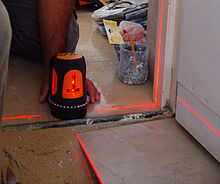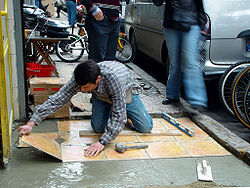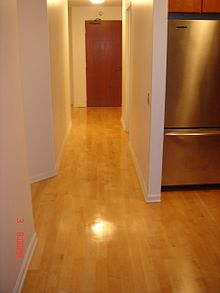- Flooring
-
 Levelling of ceramic tiles floor with a laser device
Levelling of ceramic tiles floor with a laser device
Flooring is the general term for a permanent covering of a floor, or for the work of installing such a floor covering. Floor covering is a term to generically describe any finish material applied over a floor structure to provide a walking surface. Both terms are used interchangeably but floor covering refers more to loose-laid materials.
Materials almost always classified as floor covering include carpet, area rugs, and resilient flooring such as linoleum or vinyl flooring. Materials commonly called flooring include wood flooring, ceramic tile, stone, terrazzo, and various seamless chemical floor coatings.[1]
Contents
Subfloor
Main article: SubfloorThe floor under the flooring is called the subfloor. This provides the support for the flooring. Special purpose subfloors like floating floors, raised floors or sprung floors may be laid upon another underlying subfloor which provides the structural strength.
Flooring materials
The choice of material for floor covering is affected by factors such as cost, endurance, noise insulation, comfort and cleaning effort. Some types of flooring must not be installed below grade (lower than ground level), and laminate or hardwood should be avoided where there may be moisture or condensation.
The sub-floor may be finished in a way that makes it usable without any extra work, see:
- Earthen floor adobe or clay floors
- Solid ground floor cement screed or granolithic
Soft coverings
Carpet is a floor covering woven or felted from natural or man-made fibers. Fitted carpet is attached to the floor structure, extends wall-to-wall, and cannot be moved from place to place. An underlay will extend carpet life and improve comfort.
Rugs are also woven or felted from fibers, but are smaller than the room in which they are located, have a finished edge, and usually lie over another finished floor such as wood flooring. Rugs may either be temporarily attached to the flooring below by adhesive tape or other methods to prevent creep, or may be loose-laid.
Wood flooring
Many different species of wood are fabricated into wood flooring in two primary forms: plank and parquet. Hardwoods are typically much more durable than softwoods. Reclaimed lumber has a unique appearance and is used in green (environmentally responsible) building.
Laminate is a floor covering that appears similar to hardwood but is made with a plywood or medium density fiberboard ("MDF") core with a plastic laminate top layer. HDF laminate consists of high density fiberboard topped by one or more layers of decorative paper and a transparent protective layer. Laminate may be more durable than hardwood, but cannot be refinished like hardwood. Laminate flooring is available in many different patterns which can resemble different woods or even ceramic tile. It usually locks or taps together.
Bamboo flooring is a floor manufactured from the bamboo plant and is a type of hardwood flooring, though technically not a wood. Bamboo is known to be durable and environmentally friendly. It is available in many different patterns, colors, and textures.
Cork Flooring is a flooring material manufactured from the by-product of the cork oak tree. Cork floors are considered to be eco-friendly since the cork oak tree bark is stripped every nine to ten years and doesn't damage the tree. Cork flooring comes in both tiles and planks, and can have glue or glues-less installation.
Resilient flooring
Resilient flooring is made of material that has some elasticity. It includes many different manufactured products including linoleum, sheet vinyl, vinyl composition tile (VCT), cork (sheet or tile), rubber, and others. Performance surfaces used for dance or athletics are made of either wood or resilient flooring.
Hard flooring
 Ceramic tiles flooring in Istanbul street
Ceramic tiles flooring in Istanbul street
Ceramic tile includes a wide variety of clay products fired into thin units which are set in beds of mortar or mastic with the joints between tiles grouted. Varieties include quarry tile, porcelain tile, terracotta tile, and others.
Many different natural stones are cut into a variety of sizes, shapes, and thicknesses for use as flooring. Stone flooring is usually set in mortar and grouted similar to ceramic tile. Slate and marble are popular types of stone flooring.
New technologies are emerging since 2004 to produce hard floorings having the ability to light up when needed. These security glazing materials contain transparent LED embedded films laminated between glass[2]:
Terrazzo consists of marble or other stone aggregate set in mortar and ground and polished to a smooth surface.
A Mosaic consists of many small pieces of stone arranged to form a design or picture and are common in cultural and religious centers.
Seamless chemical flooring
Many different seamless flooring materials are available. These are usually latex, polyester, urethane or epoxy compounds which are applied in liquid form to provide a completely seamless floor covering. These are usually found in wet areas such as laboratories or food processing plants. These may have granular or rubberized particles added to give better traction.
Sustainable flooring
Main article: Sustainable flooringSustainable flooring is produced from sustainable materials (and by a sustainable process) that reduces demands on ecosystems during its life-cycle. Some think that sustainable flooring creates safer and healthier buildings and guarantees a future for traditional producers of renewable resources that many communities depend on.[3]
Flooring tools
Special tools used for flooring include:
- Flooring clamp, a clamp for tongue-and-groove floors while nailing
- Knee kicker, used to position carpets precisely and stretch small areas, like steps
- Concrete moisture meter used to check a concrete floor before laying flooring on top
Floor features
There are a number of special features that may be used to ornament a floor or perform a useful service:
- Floor medallions decorative centerpieces of a floor design
- Doormats to help keep a floor clean
- Gratings used to drain water or to rub dirt off shoes
- Tactile or rumble strips to warn of for instance a wheelchair ramp, these would normally also be distinctively colored or patterned.
- Light strips to show an escape route out, especially on airplanes.
- Moldings or baseboards to decorate the sides of a floor or to cover the edge of a floating floor.
- Anti-Slip Devices The addition of either granular or rubberized particles that will allow wheels, shoes, or feet better traction.
Issues with floors
Wood floors, particularly older ones, will tend to 'squeak' in certain places. This is caused by the wood rubbing against other wood, usually at a joint of the subfloor. Firmly securing the pieces to each other with screws or nails will remove this problem.
Floor vibration is a particularly annoying problem with floors. Wood floors tend to pass sound, particularly heavy footsteps and low bass frequencies.[4] Floating floors can reduce or eliminate this problem. Concrete floors are usually so solid they do not have this problem, but are also much more expensive to construct, and much heavier, resulting in further requirements regarding the structure of the building.
The flooring may need protection sometimes (e.g., a gym floor used for a graduation ceremony). A Gym floor cover can be used to reduce the need to satisfy incompatible requirements.
See also
- Floor cleaning
- Indoor garden
- Road surface
- Sidewalk
References
- ^ World Floor Covering Association
- ^ [1] Information on LED Embedded Films and LED embedded glass
- ^ Top 5 Green Building Strategies - EPA Publication 909-F-07-001
- ^ Common Failures of Wood Structures - by Paul Fisette – © 2002
Categories:- Floors
Wikimedia Foundation. 2010.




